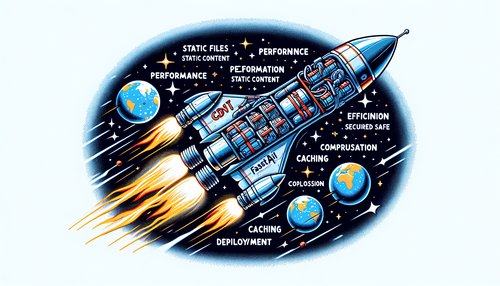Mastering FastAPI: A Comprehensive Guide to Handling User Requests, Forms, and Files Like a Pro!
With the rapid advancement in web development technologies, Python's FastAPI stands out as a modern, fast (high-performance) web framework for building APIs with Python 3.7+ based on standard Python type hints. FastAPI allows for the creation of APIs that are not only quick and easy to build but also robust and scalable. This comprehensive guide aims to take you through the nuances of handling user requests, forms, and files in FastAPI, ensuring that you're well-equipped to tackle your next web development project with confidence.
Understanding User Requests in FastAPI
At the heart of any web application or API is the handling of user requests. FastAPI simplifies this process, providing a straightforward way to define the types of requests your application can handle. Let's delve into how FastAPI processes these requests and how you can master their handling to create responsive, efficient APIs.
Path Parameters and Query Parameters
In FastAPI, path parameters can be defined directly in the path of the route, allowing for dynamic, resource-specific URLs. Similarly, query parameters can be effortlessly handled by defining them as function arguments. Practical tips for mastering these include using Pydantic models to validate and document your parameters automatically, enhancing both the reliability and usability of your API.
Request Body - Leveraging Pydantic
Handling more complex data comes into play when dealing with the request body. FastAPI leverages Pydantic models for data validation, serialization, and documentation out of the box. This approach not only simplifies the developer's job but also ensures that the data adheres to the specified schema, reducing errors and improving client-side interaction.
Mastering Forms and File Uploads in FastAPI
Moving beyond simple request handling, FastAPI also provides robust support for forms and file uploads, essential components for many web applications.
Handling Forms
FastAPI makes handling forms straightforward, using the same declaration syntax as for query parameters and request bodies. When dealing with forms, one practical tip is to use FastAPI's Form class to define form fields, ensuring that data is correctly validated and encoded.
File Uploads
Uploading files is another common requirement, and FastAPI simplifies this process as well. Files can be uploaded using FastAPI's File and UploadFile classes. A key insight here is to take advantage of UploadFile's asynchronous file writing capabilities to handle larger files without blocking the server, enhancing the overall performance of your application.
Advanced Tips for Professional FastAPI Development
To truly master FastAPI, one must go beyond the basics. Here are some advanced tips and insights:
- Dependency Injection: FastAPI's dependency injection system is a powerful feature for reusing components and ensuring clean, maintainable code. Use it to handle common functionalities like database connections and user authentication.
- Middleware: Middleware allows you to process requests before reaching your endpoint logic and modify responses before returning to the client. This is especially useful for tasks like request logging, CORS handling, and more.
- Background Tasks: For operations that don't need to be completed before sending a response to the client, FastAPI provides background tasks. This can be used for sending emails, processing data, or any other task that can be executed asynchronously.
Conclusion
Mastering FastAPI involves understanding the intricacies of handling user requests, forms, and files, along with leveraging advanced features for professional-grade API development. By embracing FastAPI's simplicity, performance, and flexibility, and applying the practical tips and insights shared in this guide, you'll be well on your way to creating APIs that are not only powerful and efficient but also a pleasure to work with. Whether you're building a small project or a large-scale application, FastAPI has the tools and features you need to succeed. So why wait? Dive into FastAPI today, and start building better APIs faster.
Remember, the journey to mastering FastAPI is ongoing. Keep experimenting, keep learning, and most importantly, keep building. Your next API could be the one that changes the game.
Recent Posts

Unlocking the Power of Terraform: Mastering Conditional Expressions for Smarter Infrastructure Automation

Unveiling the Future: Navigating the Public Interface of Apache Airflow for Streamlined Workflow Management
Apache Airflow
Mastering Workflow Automation: Unconventional Apache Airflow How-To Guides for the Modern Data Enthusiast
Apache Airflow
Mastering the Cloud: Unveiling AWS CloudFormation Best Practices for Seamless Infrastructure Management


